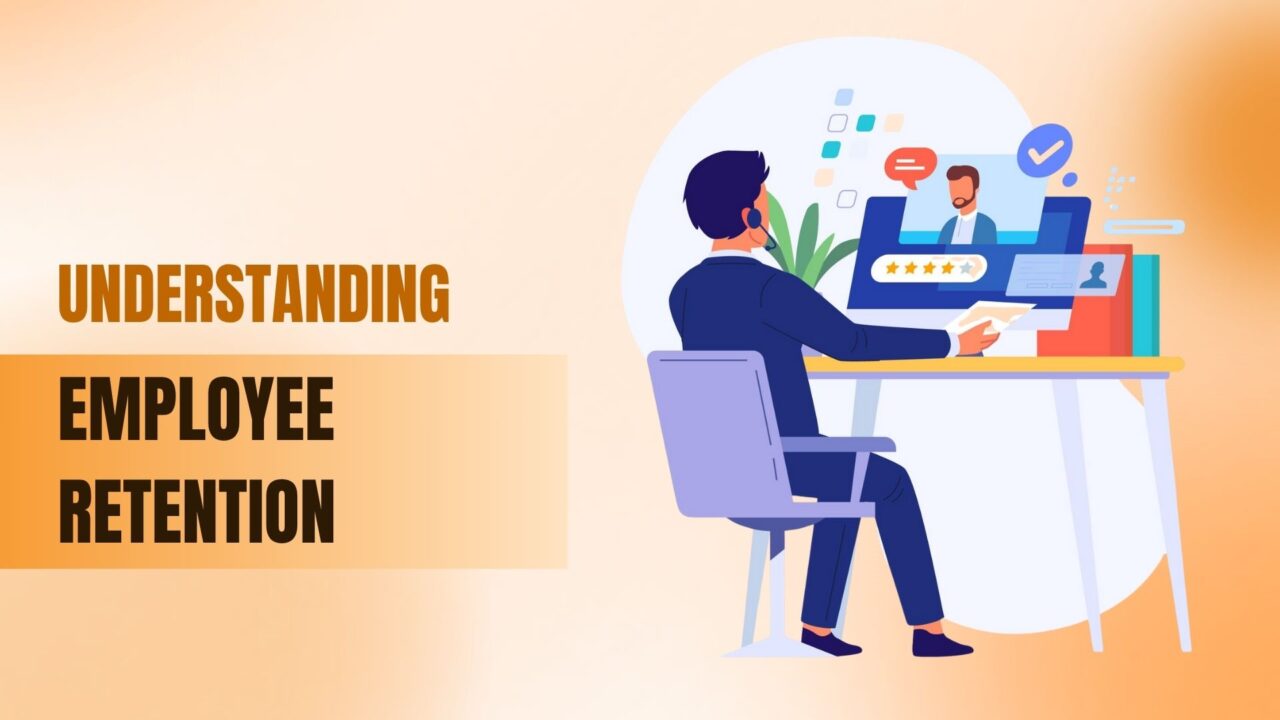The Indian business landscape is undergoing rapid transformation, with increasing talent mobility across key hubs such as Bengaluru, Hyderabad, and Mumbai. As competition for skilled professionals intensifies, retention in HRM has become a top priority for organisations aiming to build stable and high-performing teams.
Employee retention refers to an organisation’s ability to sustain its workforce by creating meaningful employee experiences that go beyond basic job satisfaction. It involves strategic efforts to reduce voluntary turnover through supportive culture, growth opportunities, and long-term engagement.
Key Takeaways
- Retention in HRM refers to keeping employees satisfied, thereby encouraging them to stay longer.
- People stay when the culture is good, the pay is fair, and they see opportunities for growth.
- Strong HR policies and a smooth start help build loyalty early on.
- Using data and feedback helps spot problems and improve retention.
- Flexibility, wellness, and smart HR tech are key to keeping teams engaged.
Definition and Scope of Employee Retention
Employee retention refers to how well an organisation creates an environment where employees are motivated to stay long-term. This involves aligning company culture with employee values, offering career growth, ensuring fair compensation, and providing meaningful work.
Retention applies across all job levels, from new hires to senior leaders, and encompasses both preventive measures to reduce attrition and proactive efforts to foster loyalty. In India’s diverse workforce landscape, retention strategies must adapt to regional preferences and generational expectations across sectors and cities.
In human resource management, retention plays a critical role in reducing hiring costs, preserving institutional knowledge, and maintaining business continuity. It is not just about preventing resignations but about fostering a workplace where people want to stay and grow.
When integrated into broader HR strategies, such as recruitment, performance management, and employee engagement, retention efforts become more effective. Strong retention also supports long-term business success by improving productivity, sustaining team cohesion, and reinforcing company culture. In India, where average retention rates hover around 80-85%, businesses that exceed these benchmarks often enjoy a competitive advantage.
Understanding Employee Retention in HRM
Employee retention within HRM represents a systematic approach to creating workplace conditions that naturally encourage long-term employment relationships. This strategic focus requires understanding the complex interplay between organisational culture, individual motivations, and market dynamics.
Key Components of Retention in HRM
Effective employee retention is built on multiple strategic elements that work together to foster long-term commitment and satisfaction. Below are the key components that HR leaders should focus on to strengthen retention efforts:
- Competitive compensation that reflects industry standards and rewards performance
- Career development opportunities offering clear paths for growth and advancement
- Positive work culture that promotes inclusion, collaboration, and well-being
- Strong leadership and management practices that support employee engagement
- Clear communication channels to ensure transparency and consistent updates
- Recognition programmes that value and celebrate employee contributions
- Flexible work options that promote work-life balance and adaptability
- Ongoing learning and training to help employees upskill and stay motivated
- Performance feedback systems that guide progress and clarify expectations
Also read: The Role of Employee Experience in Retention and Recruitment
Role of HRM in Fostering a Retention-Friendly Environment
HR professionals are responsible for creating policies and workplace conditions that support employee satisfaction and long-term engagement. This involves not only designing structured systems to address common retention issues but also continuously monitoring employee sentiment, identifying risks, and taking timely action. Modern HRM utilises data and analytics to predict potential exits and apply targeted interventions, thereby aligning employee expectations with business needs while maintaining a positive and supportive culture.
Connection Between Employee Retention and HR Policies
Well-crafted HR policies form the foundation of successful retention efforts by providing consistency, transparency, and clarity across the employee lifecycle. Policies related to compensation, performance management, and career growth directly influence how employees perceive fairness and opportunity. When these policies are integrated across all HR functions, they reinforce trust and reduce uncertainty, ensuring retention goals are supported at every stage from hiring to exit.
Ready to transform your retention approach? V3 Staffing helps organisations across Bengaluru, Hyderabad, and Mumbai develop comprehensive retention strategies that align with your business goals. Our domain expertise ensures practical solutions that work in India’s competitive talent market.
Factors Contributing to Employee Retention
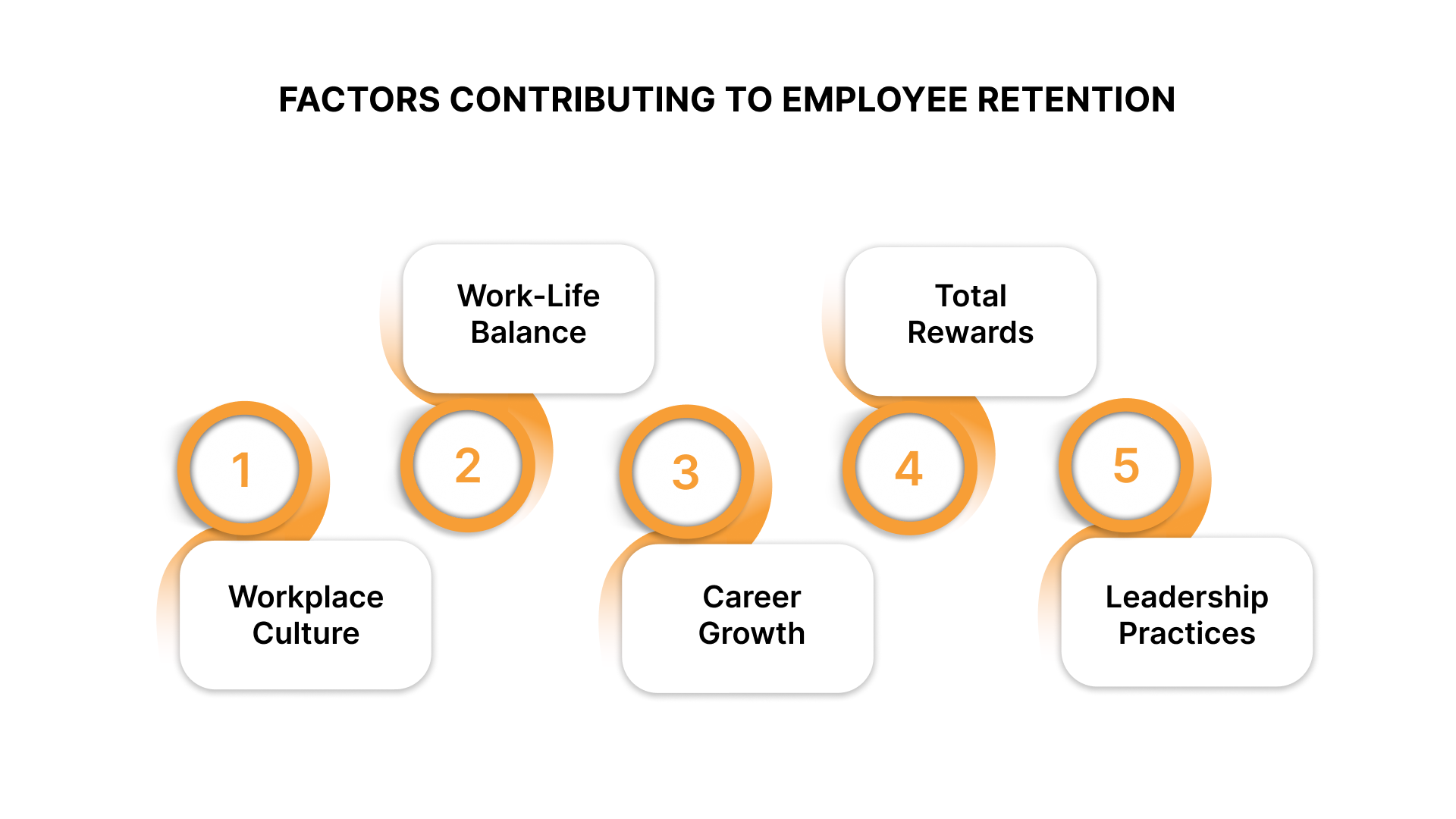
Several key elements influence whether employees choose to stay or leave their organisation. Below are the most important drivers of long-term retention and how organisations can effectively act on them.
- Organisational Culture and Its Influence on Retention
A strong, positive workplace culture fosters emotional connection and a sense of belonging by promoting inclusive policies, encouraging open communication, and regularly recognising employee contributions.
- Supportive leadership and an inclusive management style
- Transparent communication across teams and levels
- Involvement in decision-making processes
- A healthy work environment and well-maintained office spaces
- Recognition of employee contributions and team wins
- Work-Life Balance Initiatives
Providing flexibility and support for personal time has become essential for retaining today’s workforce.
- Flexible start and end times that suit personal needs
- Remote or hybrid work options to reduce commute stress
- Sabbatical leave for personal priorities or rest
- Childcare assistance and family-inclusive policies
- Wellness programmes for mental and physical health
- Career Advancement and Professional Development Opportunities
Employees are more likely to stay when they see a future with the company and access to skill-building resources.
- Clearly defined career paths and promotion criteria
- Mentorship programmes to guide career growth
- Training and upskilling initiatives
- Learning aligned with personal goals and market needs
- Time and budget allocated for continuous development
- Compensation and Benefits Strategies
Fair pay matters, but comprehensive packages have a more significant impact on long-term employee retention.
- Annual salary reviews based on performance and market rates
- Incentives tied to goals and achievements
- Robust benefits, including healthcare and insurance
- Profit-sharing or equity plans for eligible roles
- Non-monetary recognition that values employee effort
- Effective Management and Leadership Practises
Strong leadership is central to building trust, motivation, and long-term commitment.
- Consistent one-on-one meetings for feedback and development
- Clear role expectations and performance goals
- Regular recognition of employee successes
- Active support for growth and promotions
- Managers are open to feedback and employee concerns
Strategies for Improving Employee Retention
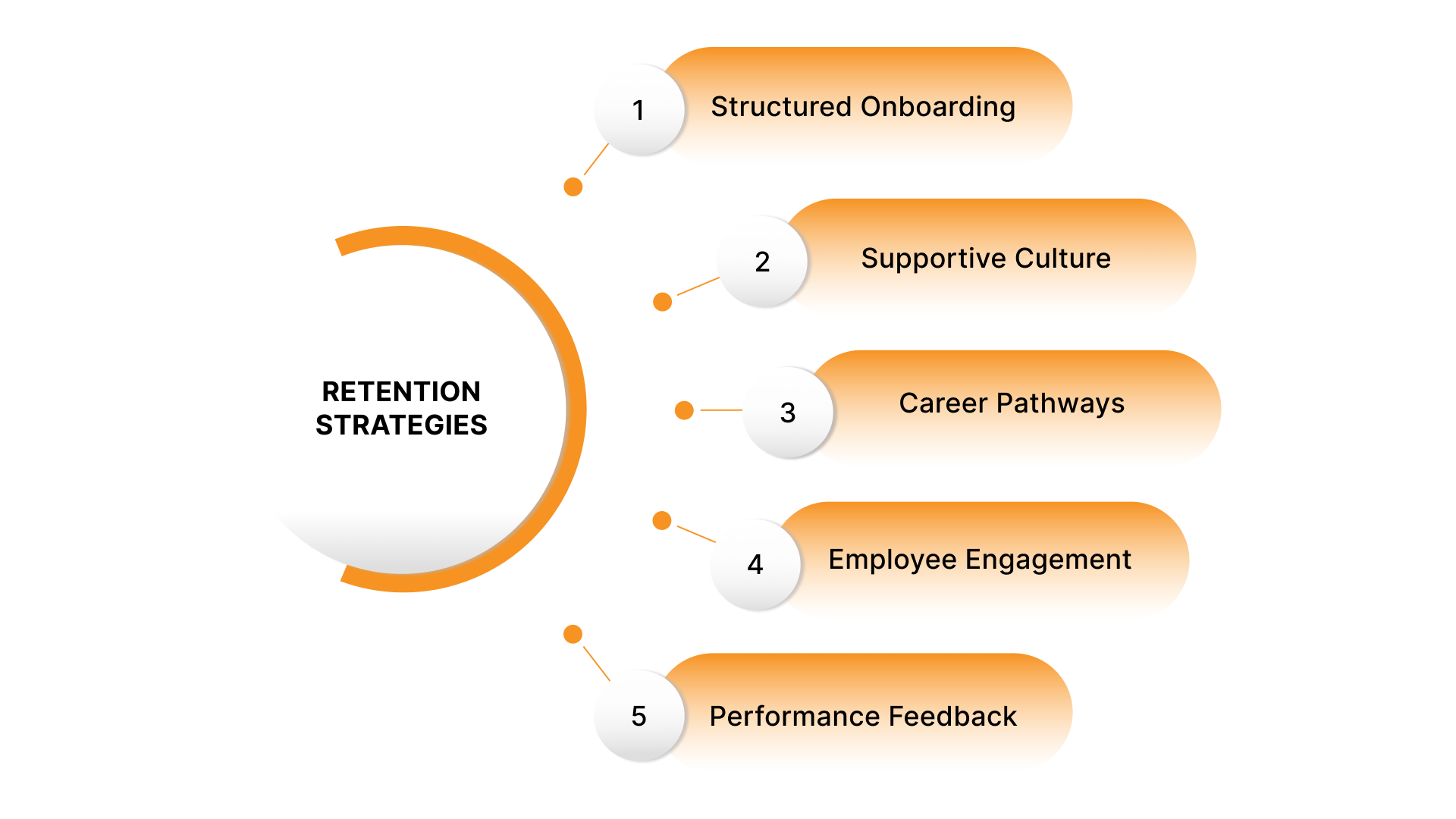
Retention improves when organisations address key areas of the employee experience. Below are practical strategies that help employees feel supported, valued, and motivated to stay.
- Implementing Comprehensive Onboarding Programmes
A well-structured onboarding process increases retention and productivity by ensuring new hires feel confident and connected.
- Orientation sessions that clarify policies, roles, and expectations
- Assigned mentors for guidance during the initial phase
- Cultural activities that help new hires understand values and behaviours
- Early project assignments to build confidence and contribution
- Regular check-ins during the first 90 days to support adjustment
- Creating a Positive and Supportive Work Culture
Strong work cultures foster loyalty, collaboration, and trust by making employees feel respected and included.
- Leaders who model inclusive and respectful behaviour
- Team-building exercises that strengthen collaboration
- Open communication to maintain transparency across levels
- Recognition programmes that celebrate both small and big wins
- Constructive conflict resolution processes to address concerns early
- Providing Clear Career Pathways
Employees stay longer when they see defined growth opportunities that align with their skills and ambitions.
- Competency maps that outline the skills needed for each role
- Personal development plans for career growth
- Mentorship support to guide progress
- Cross-functional assignments to expand experience
- Regular career conversations to explore interests and options
- Enhancing Employee Engagement and Motivation
Motivated employees are more committed and likely to remain when their work feels meaningful and rewarding.
- Frequent surveys to understand engagement drivers
- Team discussions that allow open participation
- Challenging projects that spark interest and growth
- Public recognition of individual and team contributions
- Feedback channels to involve employees in workplace improvements
- Utilising Feedback and Performance Review Systems
Consistent feedback supports continuous improvement and strengthens trust between employees and leaders.
- Scheduled one-on-one meetings for real-time feedback
- 360-degree evaluations offering multiple perspectives
- Clear goal-setting tied to business priorities
- Development plans tailored to individual needs
- Recognition for high performance and progress
Looking to implement proven retention strategies? V3 Staffing’s RPO services help organisations in Delhi NCR, Pune, and Chennai develop comprehensive retention programmes that reduce turnover and build engaged teams. Our expertise ensures that we deliver practical solutions tailored to your industry and culture.
Challenges in Employee Retention
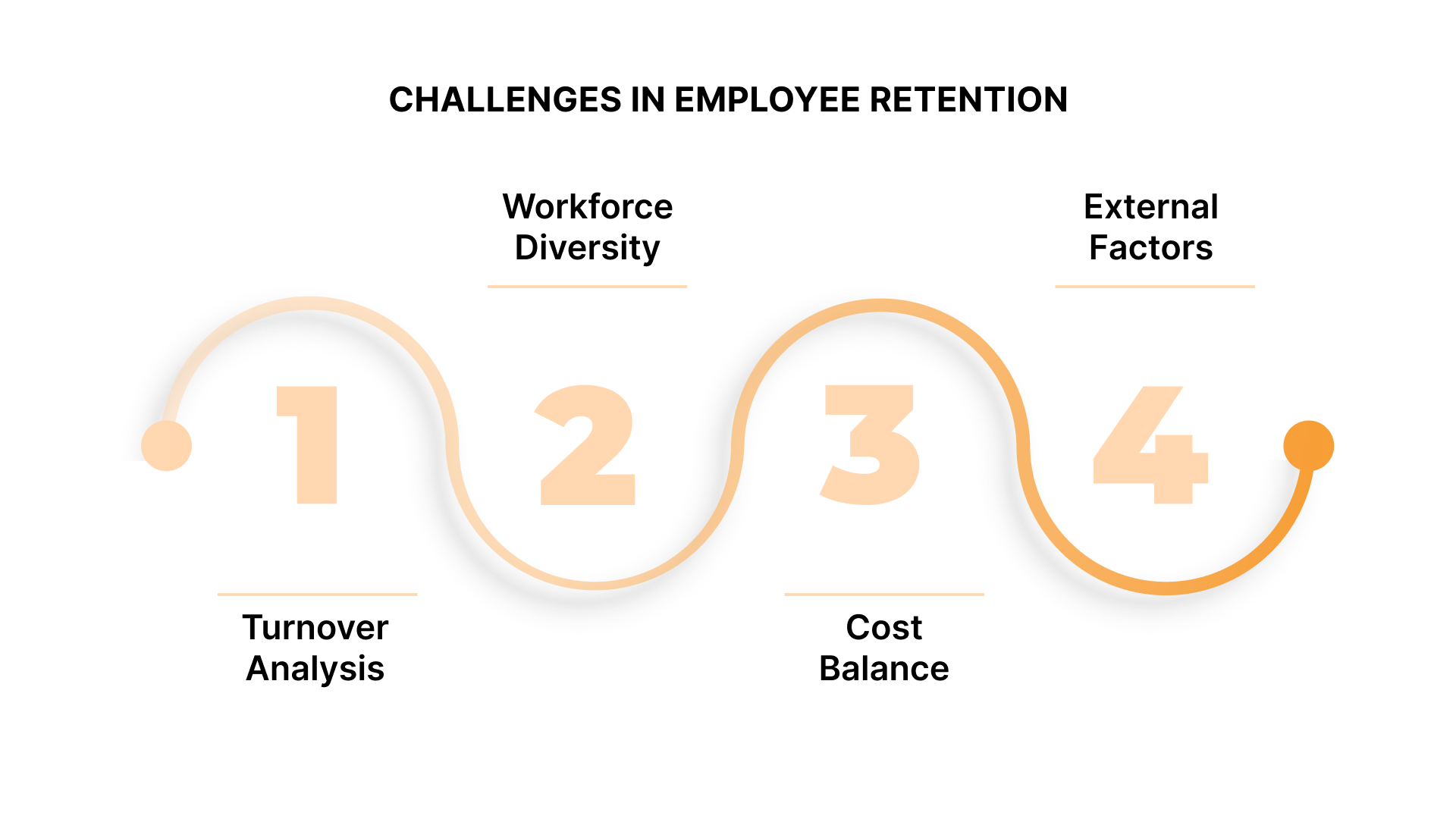
Retention efforts often encounter obstacles that necessitate strategic, data-driven solutions. Below are key challenges that organisations must address to reduce attrition effectively.
- Identifying High Turnover Patterns
Turnover data, which includes exit interviews, tenure statistics, and departmental turnover rates, when analyzed, reveals patterns that inform targeted retention strategies.
- Analyse exit interviews for common themes
- Track tenure to spot critical drop-off periods
- Review turnover rates by team or department
- Identify seasonal spikes in attrition
- Correlate turnover with manager or performance issues
- Addressing Diverse Workforce Needs
Retention must reflect the varied expectations of a multigenerational, multicultural workforce.
- Understand generational preferences for flexibility and growth
- Adapt recognition to cultural values
- Align development with different career stages
- Account for regional pay and lifestyle differences
- Tailor support based on role complexity and autonomy
- Balancing Cost and Retention Efforts
Retention strategies must offer strong ROI without straining budgets.
- Prioritise targeted, role-specific interventions
- Train managers to reduce preventable exits
- Invest in career growth to build loyalty
- Use low-cost recognition to boost morale
- Improve culture without heavy financial spend
- Dealing with External Factors Affecting Retention
Economic downturns may increase turnover risk, necessitating adaptable retention strategies, such as flexible benefits and updated compliance policies, to maintain workforce stability.
- Monitor market pay and perks to stay competitive
- Track industry shifts affecting employee expectations
- Adjust to economic fluctuations in hiring and retention
- Stay compliant with changing labour laws
- Evolve tech tools to meet modern workplace demands
Measuring and Evaluating Retention Efforts

Retention efforts must be backed by accurate data and ongoing analysis to track progress and improve outcomes.
- Key Metrics for Assessing Retention Success
These metrics help evaluate program performance and highlight gaps.
- Overall retention rate over defined periods
- Voluntary turnover rate showing employee-driven exits
- Retention by role, department, or demographic group
- Cost per hire and time-to-fill metrics
- Employee satisfaction scores from regular surveys
- Tools and Technology Used in Tracking Retention
Tech tools, such as HRIS, analytics platforms, and survey software, automate data collection and provide dashboards for actionable insights into retention.
- HR systems that track tenure and employment data
- Analytics platforms to find trends and forecast risks
- Survey tools for gathering real-time feedback
- Exit interview platforms to capture reasons for leaving
- Dashboards for visualising key retention metrics
- Analysing Retention Data to Inform HRM Strategies
Data insights turn retention metrics into actionable plans.
- Identify patterns across time, roles, and teams
- Correlate retention with leadership, pay, or engagement
- Use predictive models to spot at-risk employees
- Benchmark against industry or internal standards
- Evaluate the impact of each retention initiative clearly
Future Trends in Employee Retention
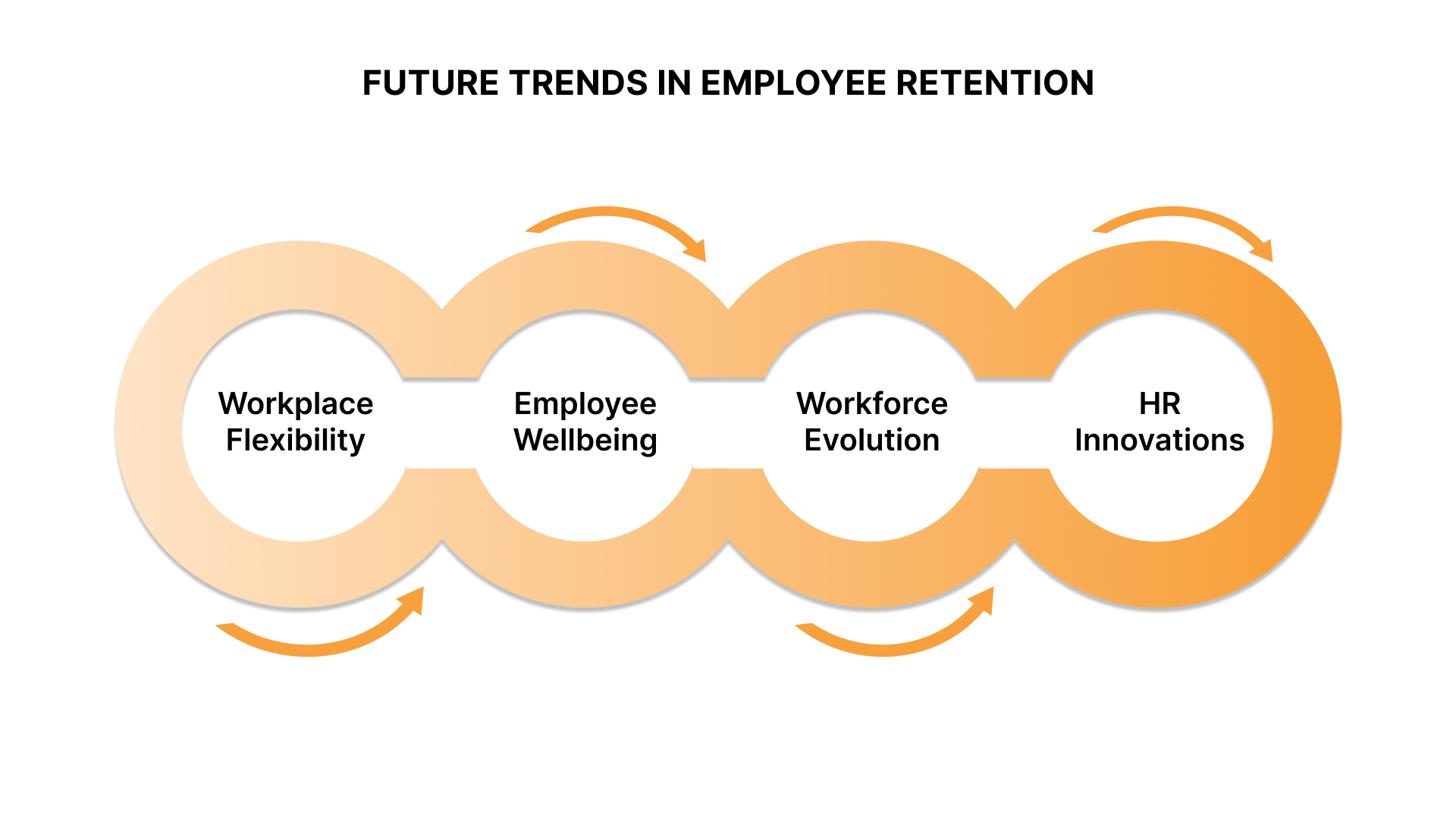
Emerging trends are reshaping how organisations retain talent. Staying ahead of these shifts is key to maintaining workforce stability and engagement.
- Impact of Remote and Hybrid Work Models
Flexible work setups require new approaches to engagement and performance.
- Invest in remote collaboration tools
- Define clear and consistent communication practises
- Update performance metrics for remote roles
- Host virtual activities to build team connection
- Ensure career growth remains accessible remotely
- Increasing Emphasis on Mental Health and Well-being
Wellness is now a central focus of employee satisfaction and retention.
- Offer confidential mental health support services
- Provide access to counselling and wellness resources
- Launch stress management and resilience programmes
- Promote work-life balance to avoid burnout
- Allow flexible schedules to support well-being
- Adapting Retention Strategies for a Changing Workforce Demographic
A younger, purpose-driven workforce calls for tailored retention efforts.
- Provide roles with social impact and a clear purpose
- Integrate digital tools to match tech-savvy preferences
- Support social responsibility and sustainability goals
- Offer flexible, customisable career tracks
- Enable continuous learning and upskilling
- Innovations in HR Technologies to Support Retention
Technology is transforming how HR teams manage and retain talent.
- Use AI tools to predict and prevent employee exits
- Offer personalised learning experiences through digital platforms
- Improve engagement with real-time communication tools
- Deploy mobile apps for easy access to HR services
- Automate admin tasks to boost employee experience
Transform your retention strategy with V3 Staffing’s expertise. We help organisations across India’s major business centres implement future-ready retention programmes that attract and retain top talent. Our comprehensive approach ensures sustainable solutions that adapt to changing workforce expectations.
Partner with V3 Staffing for Comprehensive Retention Solutions
V3 Staffing understands that effective employee retention starts with hiring the right talent from the beginning. Our domain-specialised recruiters across Bengaluru, Hyderabad, Mumbai, Delhi NCR, Pune, and Chennai help organisations build teams that naturally align with company culture and long-term objectives, reducing early turnover risks.
Through our RPO services, we embed retention-focused practises directly into your recruitment process. This includes comprehensive candidate assessment, cultural fit evaluation, and onboarding support that sets the foundation for long-term employee engagement and satisfaction.
Our expertise in permanent hiring, contract staffing, and executive search ensures that every placement considers retention factors from day one. We work closely with talent acquisition heads and HR directors to develop sustainable hiring strategies that support your broader retention objectives whilst reducing recruitment costs and time-to-hire.
Also read: Why RPO is the Ultimate Solution for Scalable Recruitment in 2025
Conclusion
Retention in HRM plays a critical role in helping Indian organisations navigate today’s competitive talent landscape. To succeed, businesses must adopt a strategic approach that encompasses compensation, workplace culture, career development, and flexibility. By combining data-driven insights with people-focused practices, HR leaders can create environments where employees choose to stay and contribute in the long term.
Strong retention in HRM leads to lower attrition costs, better knowledge retention, and improved team stability. When embedded into core HR functions, retention strategies strengthen culture and boost productivity. For Indian companies seeking long-term growth, investing in comprehensive retention programs is not only beneficial but also essential for sustaining a competitive advantage and attracting top talent.
Ready to build a retention strategy that works for your organisation? V3 Staffing brings deep expertise in employee retention across India’s major business hubs. Our proven approaches help you create compelling employee experiences that reduce turnover and build engaged teams.
Contact us today to discuss how we can support your retention objectives and drive sustainable workforce success.
FAQs
Q. How can I ask about a company’s employee turnover during an interview?
A. A good way to ask is by inquiring why the position is open. This helps reveal whether it’s a new role or a replacement, giving insight into the company’s retention history without sounding confrontational.
Q. What matters more than salary when it comes to employee retention?
A. While salary is important, factors such as empathetic leadership, work-life balance, flexible schedules, and meaningful recognition often have a stronger long-term impact on employee retention.
Q. Is competitive pay enough to keep employees from leaving?
A. Fair compensation sets the foundation, but it isn’t enough on its own. Employees also seek purpose, support, and opportunities for growth to remain committed.
Q. Do younger employees need different retention strategies?
A. Yes. Younger professionals typically value flexibility, continuous learning, and purpose-driven work. Retention strategies should reflect the evolving career expectations and lifestyle needs of employees.
Q. How can companies retain employees in roles that are routine or repetitive?
A. Small, thoughtful actions make a big difference. Respect, trust, recognition, and showing genuine interest in employee well-being can boost loyalty, even in less dynamic roles.
Q. Are exit interviews useful for improving retention?
A. Definitely. They offer honest insights into why employees leave, enabling HR teams to identify patterns and take proactive steps to enhance the overall employee experience.

